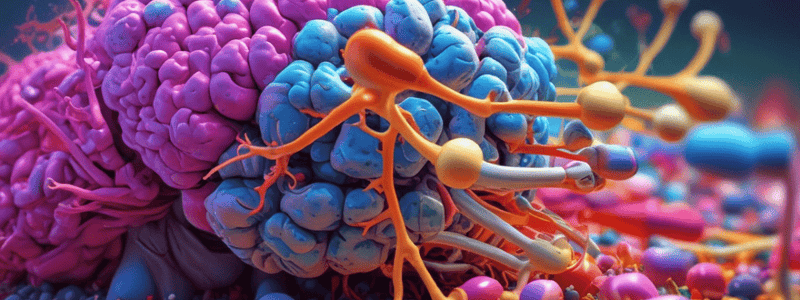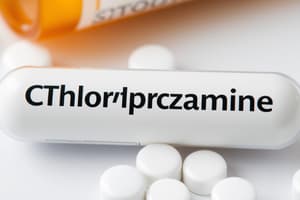Podcast
Questions and Answers
What is the most common use of the first-generation antipsychotics mentioned in the text?
What is the most common use of the first-generation antipsychotics mentioned in the text?
- Treating anxiety and insomnia
- Treating schizophrenia and acute psychosis (correct)
- Treating tourettes and severe behavioral issues in kids
- Treating bipolar disorder mania
Which of the following is NOT a potential adverse effect of the first-generation antipsychotics?
Which of the following is NOT a potential adverse effect of the first-generation antipsychotics?
- Extrapyramidal symptoms
- Hypotension
- Tardive dyskinesia
- Hypertension (correct)
What is the primary mechanism of action of the second-generation antipsychotic Clozapine?
What is the primary mechanism of action of the second-generation antipsychotic Clozapine?
- Blocking dopamine receptors and depressing the reticular activating system
- Blocking serotonin and glutamate receptors
- Anticholinergic and antihistamine activity
- All of the above (correct)
Which of the following is a potential drug interaction with Clozapine?
Which of the following is a potential drug interaction with Clozapine?
What is a contraindication for the use of Clozapine?
What is a contraindication for the use of Clozapine?
Which of the following is a potential adverse effect of the first-generation antipsychotics that is less likely to occur with the second-generation antipsychotics like Clozapine?
Which of the following is a potential adverse effect of the first-generation antipsychotics that is less likely to occur with the second-generation antipsychotics like Clozapine?
What is the primary route of administration for the first-generation antipsychotics mentioned?
What is the primary route of administration for the first-generation antipsychotics mentioned?
What are the main neurotransmitters blocked by Chlorpramazine in the CNS and PNS?
What are the main neurotransmitters blocked by Chlorpramazine in the CNS and PNS?
Which of the following conditions can be treated with Chlorpramazine besides Schizoeffective disorder?
Which of the following conditions can be treated with Chlorpramazine besides Schizoeffective disorder?
What is the mechanism of action of Haloperidol in the CNS and PNS?
What is the mechanism of action of Haloperidol in the CNS and PNS?
Which adverse effect is associated with Chlorpramazine due to the blockade of alpha adrenergic receptors?
Which adverse effect is associated with Chlorpramazine due to the blockade of alpha adrenergic receptors?
What severe condition is characterized by 'twisting/wormlike movements of tongue/face, lip smacking, and tongue darting'?
What severe condition is characterized by 'twisting/wormlike movements of tongue/face, lip smacking, and tongue darting'?
Which of the following symptoms is NOT associated with Extrapyramidal Symptoms (EPS) due to Chlorpramazine?
Which of the following symptoms is NOT associated with Extrapyramidal Symptoms (EPS) due to Chlorpramazine?
How does Chlorpramazine affect the risk of electroshock therapy?
How does Chlorpramazine affect the risk of electroshock therapy?
Study Notes
Antipsychotic Drugs
- H1, NE, Alpha 1 antagonists are used to treat schizophrenia, acute psychosis, Tourette's, and severe behavioral issues in kids.
Chlorpromazine (Thorazine)
- Low potency, first-generation antipsychotic (FGA) with conventional/neuroleptic/typical mechanism of action
- Blocks receptors in CNS and PNS: DA, AcH, H1, NE, Alpha 1, Alpha 2
- Used to reduce risk of electroshock therapy, treat schizophrenia, schizoaffective disorder, and bipolar disorder; also used for hiccups, emesis, and behavioral issues in kids
- Administered through PO, IM, IV; higher dosage required to achieve therapeutic effect
- Contraindications: CNS depression with benzodiazepines, 1st gen antihistamines, ethanol, opioids, barbiturates, and antidepressants
- Adverse effects:
- EPS: acute dystonia, parkinsonism, akathisia, tardive dyskinesia
- Anticholinergic effects: dry mouth, constipation, urinary frequency/retention, tachycardia, blurred vision
- Orthostatic hypotension due to alpha-adrenergic blockade
- Cardiac dysrhythmias
- Sedation (especially in the first week of therapy)
- Agranulocytosis (rare but serious)
- Sexual dysfunction, gynecomastia, galactorrhea, menstrual irregularity
- Increased sunlight sensitivity and risk of seizures
Haloperidol (Haldol)
- Conventional/typical/butyrophenone/nonphenothiazine neuroleptic
- Blocks multiple receptors in CNS and PNS: DA, ACH
- Mechanism of action: blocking receptors in CNS and PNS
Clozapine (Clozaril)
- Second-generation atypical antipsychotic
- Blocks DA receptors, depressing the reticular activating system, as well as serotonin and glutamate receptors; also has anticholinergic, antihistamine, and alpha-adrenergic blocking activity
- Used to treat schizophrenia, bipolar disorder, and severe behavioral problems in autistic children
- Administered through PO, IM
- Decreased drug levels with: barbiturates, rifampin, tegretol, dilantin, ethanol, and benzodiazepines
- Increased drug levels with many antifungals, erythromycin, quinidine, and SSRIs
- Adverse effects:
- HA, agitation, nervousness, anxiety, insomnia, NV, dizziness, somnolence
- EPS, orthostatic hypotension, weight gain, DM, dyslipidemia
- Acute dystonia: laryngospasm
Studying That Suits You
Use AI to generate personalized quizzes and flashcards to suit your learning preferences.
Description
Test your knowledge on Chlorpromazine (Thorazine), a low potency first-generation antipsychotic with various effects on neurotransmitter receptors. Learn about its mechanism of action, uses, dosage forms, drug interactions, adverse effects, and more.




